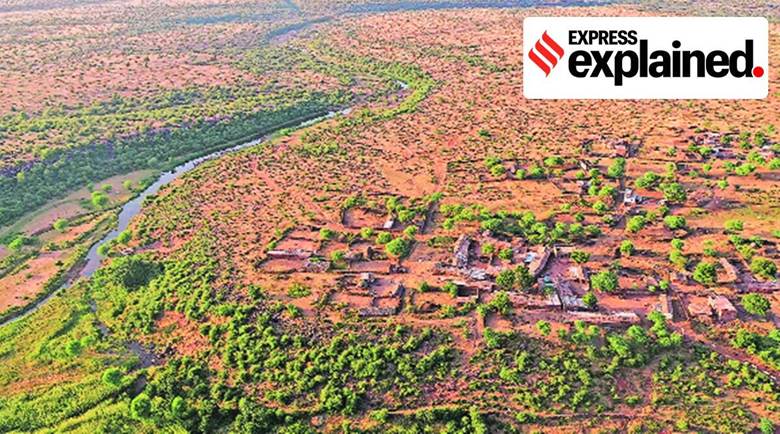Description

Copyright infringement is not intended
Context: The Union Ministry of Environment, Forest and Climate Change has objected to the transfer of thousands of hectares of land without following due process by Chhattisgarh from its Forest to the Revenue Department for setting up industries and for building road, rail, and other infrastructure.
More on the news:
- While the Chhattisgarh government has described these areas as non-forest land that were earlier given “by mistake” to the Forest Department, the Environment Ministry has warned that the land in question is “undemarcated protected forests”, which cannot be used for non-forest purposes without clearance under the Forest Conservation (FC) Act, 1980.

Forests in law:
- Broadly, state Forest Departments have jurisdiction over two types of forests notified under the Indian Forest (IF) Act, 1927: Reserve Forests (RF), where no rights are allowed unless specified; and Protected Forests (PF), where no rights are barred unless specified. Certain forests, such as village or nagarpalika forests, are managed by state Revenue Departments.
- The FC Act, 1980, applies to all kinds of forests, whether under the control of the Forest or the Revenue Department, and it requires statutory clearance before forests can be used for any non-forest purpose such as industry, mining, or construction.
- In 1976, forests were included in List III (Concurrent List) under the Seventh Schedule of the Constitution.
Chhattisgarh case:
- The recorded forest area in Chhattisgarh covers 44.21% of its geography. The state government says it is constrained by the limited availability of land, particularly in the tribal regions, for development works.
- Therefore, in May 2021, the state Revenue Department sought a field survey to identify non-forest land — parcels smaller than 10 hectares with less than 200 trees per hectare — “that had been included by mistake” in “Orange Areas” under the Forest Department.
- This March, Chief Minister Bhupesh Baghel announced that over 300 sq km of “Orange” area in the Bastarregion had been handed over to the Revenue Department.
- Under the zamindari system, villagers used local malguzari (livelihood concessions) forests for firewood, grazing, etc. When zamindari was abolished in 1951, malguzari forests came under the Revenue Department. In 1958, the government of undivided Madhya Pradesh notified all these areas as PFs under the Forest Department.
- Through the 1960s, ground surveys and demarcations of these PFs continued — either to form blocks of suitable patches to be declared as Reserve Forests, or to denotify and return to the Revenue Department.
- For this purpose, Madhya Pradesh amended the IF Act, 1927, in 1965 — when forests figured in the State List — to allow denotification of PFs. The areas yet to be surveyed — undemarcated PFs — were marked in orange on the map.
- Since 2003, a case has been pending in the Supreme Court on rationalising these orange areas that have remained a bone of contention between the two Departments.
- The transfer of PFs to the Revenue Department continued until 1976, when reports of illicit felling in Revenue areas prompted Madhya Pradesh to seek a fresh survey to shift quality forest patches back to the Forest Department.
- But before this survey could be undertaken, the new government that came to power in the state in 1978 switched the focus to settling encroachments.
- The FC Act came in 1980, and required central clearance for non-forest use of forest land. This led to a situation where the rights of lakhs of villagers, including those settled by the government through pattas, remained restricted.
- In 2020, a task force set up by Madhya Pradesh to resolve the deadlock recommended that patta-holders should not be considered encroachers since they were given land by government officials, and they “should be settled after obtaining permission from the Government of India” with a cut-off year of 1976.
- In December 1996, the SC defined ‘forest’ after its dictionary meaning, irrespective of the status of the land it stands on. It also defined forestland as any land thus notified on any government record irrespective of what actually stands on that land.
- To meet this broad definition, Madhya Pradesh in 1997 framed a “practical yardstick” — an area no smaller than 10 hectares with at least 200 trees per hectare — to identify forests in Revenue areas for handing over to the Forest Department.
- As the process continued until 2007 — after Chhattisgarh had come into existence — state officials claim, some non-forest areas also came under the Forest Department as part of 2,328 sq km added to the “9,954 sq km original Orange Areas of 1950s” inherited from Madhya Pradesh. These non-forest areas, they claim, are now being identified and returned to the Revenue.
Does this hold?
- First, a senior official in the Environment Ministry said, the nature of vegetation changes over time. After so many years, a visual survey cannot determine if a particular piece of land did not meet the definition of forest at the time when it was brought under the Forest Department.
- Second, the official said, once brought under the Forest Department, whether mistakenly or otherwise, an area gets the status of forestland as per the 1996 SC order, and hence comes under the FC Act, 1980.
- The other view is that Chhattisgarh, thanks to the 1965 amendment to the IF Act, can still denotify PFs unilaterally. It may also vest management of any land with any department since the state owns all land within its boundaries.
- But if the stated purpose is non-forest use — building industries and infrastructure — the state will anyway require central clearance under the FC Act, 1980.
https://indianexpress.com/article/explained/explained-chhattisgarh-forest-by-mistake-8114153/














